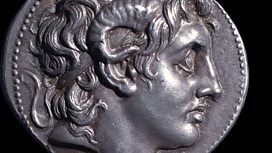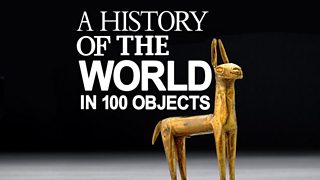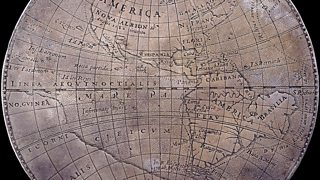Benin plaque - the Oba with Europeans
Neil MacGregor's is describing the impact of the European age of discovery between 1450 and 1600. Today he is with some of Africa's most famous artworks, the Benin Plaques.
This week Neil MacGregor's history of the world is exploring the impact of the great European age of expansion and discovery during the 15th and 16th Centuries. In the last programme he described the technology that allowed Europeans to sail around the world in great galleons, the "space ships of their age". Today he looks at what happens when Europeans started trading in West Africa and first came upon the ancient culture of Benin in present day Nigeria. Neil describes the world of this hugely successful warrior kingdom and the culture that produced such exquisite artwork. He also describes what happened when the British raided Benin at the end of the 19th Century and the effect that these brass portraits first had when they arrived in London. The artist Sokari Douglas Camp reflects on the sculptures as art while the Nigerian poet and playwright Wole Soyinka reacts to the violent history of Benin and the loss of part of their great heritage.
Producer: Anthony Denselow
Last on
![]()
More programmes from A History of the World in 100 Objects related to leaders & government
About this object
Location: Benin, Nigeria
Culture: African Cultures
Period: AD 1400 -1600
Material: Metal
��
The figure at the centre of this brass plaque is the oba - the king of Benin in Nigeria. In the background on either side of the oba are two tiny figures, identified as Portuguese traders, characterised by their long hair and European-style hats. Two attendants kneel beside the oba, indicating the hierarchical nature of royal power in Benin. In pre-Colonial times the king was regarded as the highest political and religious authority and respected as the representative of the ancestors.
How did European brass spark an artistic renaissance in Benin?
The kingdom of Benin dominated trade with Europeans on the Nigerian coast from the late 1400s to the end of the 1900s. When Portuguese traders arrived in Benin in the 1400s they brought brass bracelets, known as manillas, to exchange for pepper, ivory and slaves. The artists of Benin transformed this European brass into plaques to decorate the oba's palace. When these plaques were first seen in Europe in the late 1890s they astounded art critics who couldn't believe that such technically accomplished sculptures were created by African artists.
Did you know?
- There are over 900 brass plaques from Benin in various museums in Europe and America.
The mastery of technology and art
By Wole Soyinka, Nigerian poet and playwright
��
When I see a Benin bronze, I immediately think of the mastery of technology and art – the welding of the two. I think immediately of a cohesive ancient civilisation. It increases a sense of self-esteem because it makes you understand that African society actually produced some great civilisations, established some great cultures, and today it contributes to one’s sense of the degradation that has overtaken many African societies, to the extent that we forget that we were once a functioning people before the negative incursion of foreign powers.
What happened to the Benin kingdom is a reminder of what happened in many, many other parts of the African continent. The looted objects are still today politically loaded. The Benin bronze, like other artefacts, is still very much a part of the politics of contemporary Africa and, of course, Nigeria in particular.
The kingdom of Benin
By Claude Ardouin, curator, British Museum
��
This plaque is one of the relief brass-cast plaques that once used to decorate the palace of the oba (king) in Benin City, the capital of the Benin (Edo) kingdom (in modern southern Nigeria).
The palace complex was set up around atrium courtyards. Some had galleries with wooden pillars supporting the roofwith brass-cast plaques fixed to them. During the British Expedition of 1897 around 900 plaques were found.
The plaques are cast in the lost-wax technique, with relief images. Some of them celebrate successful wars or historical events, while others are a vivid depiction of Benin court life and ritual in the 1500s.
The plaques date to the 1500s and 1600s. That period is known as the time of the warrior-kings and is considered to be the golden age of the Benin Kingdom. It was a time of growth and consolidation under famous rulers such as Oba Esigie (about 1504-1550). They expanded the kingdom and made it a leading military, political, and economic power in the Guinea Gulf. At its peak its influence expanded over a vast territory around the Niger River Delta. In that period Benin achieved great prosperity through military conquests and trade.
The first contacts between Benin and Europe took place with the Portuguese in the late 1400s, leading to intensive trade relations which were maintained until the mid-1500s and brought immense wealth to the kingdom. Following the Portuguese Benin intensively traded with the Dutch and the British, maintaining continuous trade with Europe over centuries. European visitors to Benin were impressed by the city, the king and his court and left accounts describing the size, scale and magnificence of the city.
Benin City was the centre of political control, and the court and palace were the political, spiritual and ceremonial heart of the Kingdom. The oba was a divine king and the spiritual, secular and ritual head of the kingdom. He was the peak of the power system that also included three classes of chiefs – the Uzama (king makers), Eghaevbo n’Ogbe (palace chiefs) and Eghaevbo n’Ore (town chiefs). State affairs such as war, taxes, and dates of important ceremonies, were decided by a state council led by the oba, formed of these three classes of chiefs and other dignitaries.
All the chiefs were under the unconditional power of the oba. The Iyoba – Mother of oba – also played a vital role in the power structure as a supreme moral authority and protective force supporting the oba. The provinces were under the control of the oba and of the power centre in Benin
Transcript
Broadcasts
- Tue 21 Sep 2010 09:45�鶹������ҳ��� Radio 4 FM
- Tue 21 Sep 2010 19:45�鶹������ҳ��� Radio 4
- Wed 22 Sep 2010 00:30�鶹������ҳ��� Radio 4
- Wed 22 Sep 2010 19:45�鶹������ҳ��� Radio 4 FM
- Tue 17 Aug 2021 13:45�鶹������ҳ��� Radio 4
Featured in...
![]()
Leaders and Government—A History of the World in 100 Objects
More programmes from A History of the World in 100 Objects related to leaders & government
Podcast
-
![]()
A History of the World in 100 Objects
Director of the British Museum, Neil MacGregor, retells humanity's history through objects





